University Or College Offer Letter
[University/College Logo]
[University/College Name]
[Address]
[City, State, Zip Code]
[Date]
Dear [Applicant's Full Name],
Congratulations!
I am pleased to inform you that you have been offered admission to [University/College Name] for the [Academic Program/Degree] commencing in the [Semester/Year]. Your application was thoroughly reviewed, and we were impressed with your academic achievements and potential to contribute to our campus community.
Admission Details:
Full Name: [Applicant's Full Name]
Student ID: [Student ID, if applicable]
Program: [Academic Program/Degree]
Commencement Date: [Semester/Year]
Duration: [Number of years or semesters]
Financial Aid (if applicable):
We are pleased to offer you the following financial assistance/scholarship/grant [if applicable]. Please refer to the attached document for detailed information on the financial aid package.
Enrollment Confirmation and Deposit:
To secure your place in the [Academic Program/Degree], we request a non-refundable enrollment deposit of [Amount] to be paid by [Deadline date]. This deposit will be credited towards your tuition fees for the first semester/year. Further instructions on how to make the payment are provided in a separate communication.
Registration and Orientation:
Details regarding the registration process, orientation schedules, and other important information will be communicated to you via email or postal mail in the coming weeks. Please keep an eye on your registered email address for these updates.
Acceptance of Offer:
To confirm your acceptance of this offer, please sign and return a copy of this letter, along with the required enrollment deposit, by the deadline mentioned above.
We hope that you will join our esteemed academic community and contribute your skills and ideas to our diverse campus. If you have any questions or need further clarification, please do not hesitate to contact the Admissions Office at [Contact Email/Phone Number].
Once again, congratulations on your acceptance to [University/College Name]. We eagerly look forward to welcoming you to our campus.
Sincerely,
Official Undergraduate Admission Offer Letter
Subject: Offer of Admission - Bachelor of Science Program
Dear [Student Name],
Congratulations! We are delighted to inform you that you have been accepted into the Bachelor of Science program at [University Name] for the Fall 2025 semester.
After careful review of your academic credentials, extracurricular achievements, and personal statement, the Admissions Committee has determined that you possess the qualifications and potential to excel in our rigorous academic environment.
Your acceptance is contingent upon successful completion of your current academic program with grades consistent with your application. You must submit your final transcripts by July 15, 2025.
To secure your place in the incoming class, please confirm your acceptance and submit the enrollment deposit of $500 by May 1, 2025. Detailed enrollment instructions and housing information will be mailed separately.
We look forward to welcoming you to our campus community.
Sincerely,
[Name]
Director of Admissions
Graduate School Conditional Offer Email
Subject: Conditional Offer - Master's Program in [Field]
Dear [Applicant Name],
We are pleased to extend a conditional offer of admission to the Master's program in [Field] at [University Name].
Your application demonstrates strong academic potential. However, this offer is contingent upon completion of the following requirements:
- Submission of official transcripts showing completion of bachelor's degree
- TOEFL score of 90 or higher (for international students)
- Proof of financial support documentation
Please submit these materials by [Date]. Upon receipt and verification, your conditional status will be converted to full admission.
The program begins on [Start Date]. Tuition and fee information is enclosed.
We encourage you to accept this conditional offer promptly, as spaces are limited.
Best regards,
[Name]
Graduate Admissions Office
Scholarship Offer Letter
Subject: Scholarship Award - [Scholarship Name]
Dear [Student Name],
Congratulations! Based on your outstanding academic achievements and demonstrated leadership potential, you have been selected to receive the [Scholarship Name] for the 2025-2026 academic year.
Award Details:
- Award Amount: $[Amount] per academic year
- Duration: Four years (renewable based on academic performance)
- Minimum GPA requirement: 3.5
- Community service requirement: 20 hours per semester
This scholarship significantly reduces your educational costs and recognizes your commitment to academic excellence. To maintain eligibility, you must remain enrolled full-time and meet the specified academic and service requirements.
Please sign and return the enclosed acceptance form by [Date] to secure this award.
We are proud to support your educational journey and look forward to your contributions to our university community.
Warmest congratulations,
[Name]
Financial Aid Director
Transfer Student Acceptance Message
Subject: Transfer Admission Decision - Welcome to [University Name]
Hello [Student Name],
Great news! Your transfer application to [University Name] has been approved for the Spring 2025 semester.
We have evaluated your coursework from [Previous Institution] and determined that [Number] credit hours will transfer toward your degree in [Major]. A detailed credit evaluation report is attached for your review.
Your expected graduation date, based on transferred credits, is [Semester/Year]. An academic advisor will contact you within two weeks to discuss your degree plan and course registration.
Next steps:
- Submit enrollment deposit: $300 (due by [Date])
- Attend transfer student orientation: [Date]
- Meet with academic advisor: [Date range]
- Register for classes: [Date range]
Transfer students bring valuable perspectives to our campus. We're excited to have you join our community!
Best wishes,
[Name]
Transfer Admissions Coordinator
Waitlist Status Notification Email
Subject: Application Status Update - Waitlist Placement
Dear [Applicant Name],
Thank you for your interest in [University Name]. After thorough review of your application for Fall 2025 admission, we have placed you on our admissions waitlist.
This placement indicates that while you are a qualified candidate, we currently do not have space available in the incoming class. Your application remains under consideration, and we will contact you if a spot becomes available.
To remain on the waitlist:
- Confirm your continued interest by responding to this email
- Submit any additional materials that might strengthen your application (optional)
- Keep us informed of significant achievements or grade improvements
Historically, we admit 15-20% of waitlisted candidates, typically between May and July.
We understand this is not the immediate answer you hoped for, but please know that being waitlisted reflects the competitive nature of our admissions process, not any deficiency in your qualifications.
Sincerely,
[Name]
Admissions Office
International Student Offer with Visa Information
Subject: Admission Offer and Visa Documentation - [University Name]
Dear [Student Name],
We are delighted to offer you admission to [University Name] for the Fall 2025 semester in the [Program Name] program.
As an international student, you will receive the following documentation to support your visa application:
- Form I-20 (for F-1 student visa)
- Official admission letter for embassy/consulate
- Financial verification letter
Important visa information:
- Estimated program cost: $[Amount] per year
- Required financial documentation: $[Amount]
- Health insurance: Mandatory ($[Amount] per year)
- Recommended visa application timeline: 2-3 months before semester start
Our International Student Services office will contact you within one week with detailed pre-arrival information and visa application guidance.
We look forward to welcoming you to our diverse, international campus community.
Best regards,
[Name]
International Admissions Office
Early Decision Acceptance Letter
Subject: Early Decision Acceptance - [University Name]
Dear [Student Name],
Congratulations! We are thrilled to inform you that you have been accepted through our Early Decision program at [University Name].
As an Early Decision candidate, your acceptance represents our strong confidence in your academic potential and fit with our institution. Your commitment to [University Name] as your first choice is deeply appreciated.
Per Early Decision agreement terms:
- You must withdraw applications from all other colleges immediately
- Enrollment deposit of $750 is due by [Date]
- Final transcript submission deadline: June 30, 2025
Your early commitment allows us to guarantee your spot in popular courses and housing options. Priority registration begins [Date].
We are excited to welcome you to the [University Name] family and look forward to supporting your academic and personal growth over the next four years.
With enthusiasm,
[Name]
Dean of Admissions
Professional Program Acceptance Message
Subject: Admission to [Professional Program] - Congratulations!
Dear [Applicant Name],
After a highly competitive selection process, we are pleased to offer you admission to the [Professional Program] at [University Name], beginning [Start Date].
Your impressive academic record, professional experience, and interview performance distinguished you among an exceptional pool of candidates.
Program highlights:
- Duration: [Length]
- Cohort size: [Number] students
- Clinical/practical training: [Details]
- Board exam pass rate: [Percentage]
Pre-enrollment requirements:
- Background check clearance
- Health and immunization records
- Professional liability insurance
- Acceptance deposit: $[Amount]
The program demands dedication and excellence. We are confident you possess the skills and commitment necessary for success in this challenging field.
Welcome to the profession!
Sincerely,
[Name]
Program Director
What is a University or College Offer Letter and Why is it Important
A university or college offer letter is an official document issued by an educational institution formally notifying an applicant of their acceptance into an academic program. This letter serves multiple critical purposes:
- Legal confirmation of admission status and program enrollment eligibility
- Documentation required for visa applications, financial aid processing, and housing arrangements
- Contract establishment outlining terms, conditions, and expectations for enrollment
- Timeline specification for acceptance deadlines, deposit requirements, and orientation dates
- Credibility verification for employers, scholarship committees, and other institutions
Who Should Send University Offer Letters
Offer letters must originate from authorized institutional representatives with proper authority:
- Admissions Directors or Associate Directors for undergraduate programs
- Graduate School Deans or Program Coordinators for advanced degrees
- Department Heads for specialized or competitive programs
- Financial Aid Directors when scholarships or funding are included
- International Student Services for students requiring visa documentation
- Registrar's Office for transfer credit evaluations and degree completion timelines
When University Offer Letters Are Sent
Multiple scenarios trigger the issuance of offer letters:
- Regular admission cycles following application review periods
- Early decision/early action deadlines for priority applicants
- Rolling admissions throughout application periods
- Waitlist movement when spaces become available
- Transfer student evaluations after credit assessments
- Conditional admission pending completion of requirements
- Scholarship awards following merit or need-based reviews
- Graduate program acceptance after interviews or portfolio reviews
How to Write and Send University Offer Letters
The writing process involves systematic steps and careful attention to detail:
- Verify student information including full legal name, contact details, and program choice
- Confirm admission decision through committee records and official documentation
- Include specific program details such as start date, campus location, and degree requirements
- State financial information including tuition, fees, deposits, and payment deadlines
- Specify next steps for enrollment confirmation, orientation attendance, and registration
- Review legal requirements for visa students, transfer credits, or conditional admissions
- Obtain proper signatures from authorized institutional representatives
- Send via secure methods ensuring delivery confirmation and document integrity
Elements and Structure of Offer Letters
Essential components that must be included in every offer letter:
- Clear subject line indicating admission decision and program name
- Formal greeting addressing the student by full legal name
- Congratulatory statement confirming acceptance and expressing enthusiasm
- Program specifications including degree type, major, campus, and start semester
- Enrollment requirements such as deposits, deadlines, and documentation
- Financial information covering tuition, fees, and payment schedules
- Contact information for admissions, academic, and student services offices
- Professional closing with authorized signature and official title
- Institutional letterhead and contact details for verification purposes
Requirements and Prerequisites Before Sending
Critical preparations that must be completed before letter distribution:
- Admission committee approval with documented decision rationale
- Student record verification ensuring accuracy of academic and personal information
- Program capacity confirmation to avoid over-enrollment issues
- Financial aid coordination if scholarships or grants are included
- International student clearance for visa documentation requirements
- Transfer credit evaluation completion for students with prior college experience
- Background check results for programs requiring clearance
- Department approval for competitive or specialized programs
Formatting Guidelines and Best Practices
Professional presentation standards for offer letters:
- Length: 1-2 pages maximum to maintain reader attention and clarity
- Tone: Professional yet welcoming, balancing formality with enthusiasm
- Font: Standard business fonts (Times New Roman, Arial) in 11-12 point size
- Spacing: Single-spaced paragraphs with double spacing between sections
- Letterhead: Official institutional branding and contact information
- Signature: Original ink signature or secure digital signature
- Delivery method: Certified mail for domestic students, secure email with PDF attachment
- Language: Clear, concise prose avoiding jargon or overly technical terms
Follow-up Actions After Sending Offer Letters
Essential steps to ensure successful student transition:
- Confirmation tracking to verify letter receipt and student response
- Deposit monitoring to ensure timely payment and enrollment security
- Documentation collection of required transcripts, health records, and forms
- Orientation coordination including session scheduling and material preparation
- Housing assistance for students requiring campus accommodation
- Academic advising appointments to discuss degree requirements and course selection
- International student support for visa applications and pre-arrival services
- Financial aid finalization if additional documentation is required
Common Mistakes to Avoid
Frequent errors that can compromise the effectiveness of offer letters:
- Incorrect student information including misspelled names or wrong programs
- Missing deadline dates for enrollment deposits or document submission
- Unclear financial information causing confusion about costs and payment terms
- Generic language that doesn't reflect the specific program or student achievements
- Incomplete contact information leaving students unable to reach appropriate offices
- Inconsistent formatting that appears unprofessional or difficult to read
- Legal compliance oversights particularly for international students or transfer credits
- Delayed sending that reduces student response time and enrollment likelihood
Pros and Cons of Different Offer Letter Approaches
Advantages of detailed offer letters:
- Provide comprehensive information reducing student confusion
- Establish clear expectations and requirements
- Demonstrate institutional professionalism and organization
- Include all necessary legal and procedural information
Disadvantages of overly complex letters:
- May overwhelm students with excessive information
- Can appear impersonal if too formal or lengthy
- Risk important details being overlooked in dense text
Benefits of concise approaches:
- Easy to read and understand quickly
- Highlight essential information effectively
- Maintain student engagement and excitement
Drawbacks of brief letters:
- May omit critical details requiring follow-up communication
- Can appear impersonal or lacking in institutional warmth
Tips and Best Practices for Effective Offer Letters
Strategic approaches to maximize impact and student response:
- Personalize content by referencing specific student achievements or program features
- Use active voice to create engaging, direct communication
- Include success stories or program highlights that build excitement
- Provide multiple contact options for different types of questions or concerns
- Create urgency appropriately without causing undue pressure or stress
- Proofread extensively to eliminate errors that undermine credibility
- Test readability with sample audiences to ensure clarity and comprehension
- Coordinate timing to align with student decision-making schedules and competing offers
Compare and Contrast with Similar Communications
Offer letters vs. acceptance notifications:
- Offer letters provide comprehensive enrollment information while notifications simply confirm admission status
- Offer letters include legal and financial details whereas notifications focus primarily on congratulations
University offers vs. scholarship awards:
- University offers address program admission while scholarship letters focus on financial recognition
- Combined letters integrate both elements but require careful balance of information priority
Conditional vs. unconditional offers:
- Conditional offers specify requirements that must be met while unconditional offers guarantee admission
- Both require clear timeline communication but conditional offers need more detailed requirement explanations
Domestic vs. international student letters:
- International letters must include visa documentation and additional compliance information
- Domestic letters can focus more on academic and social integration aspects

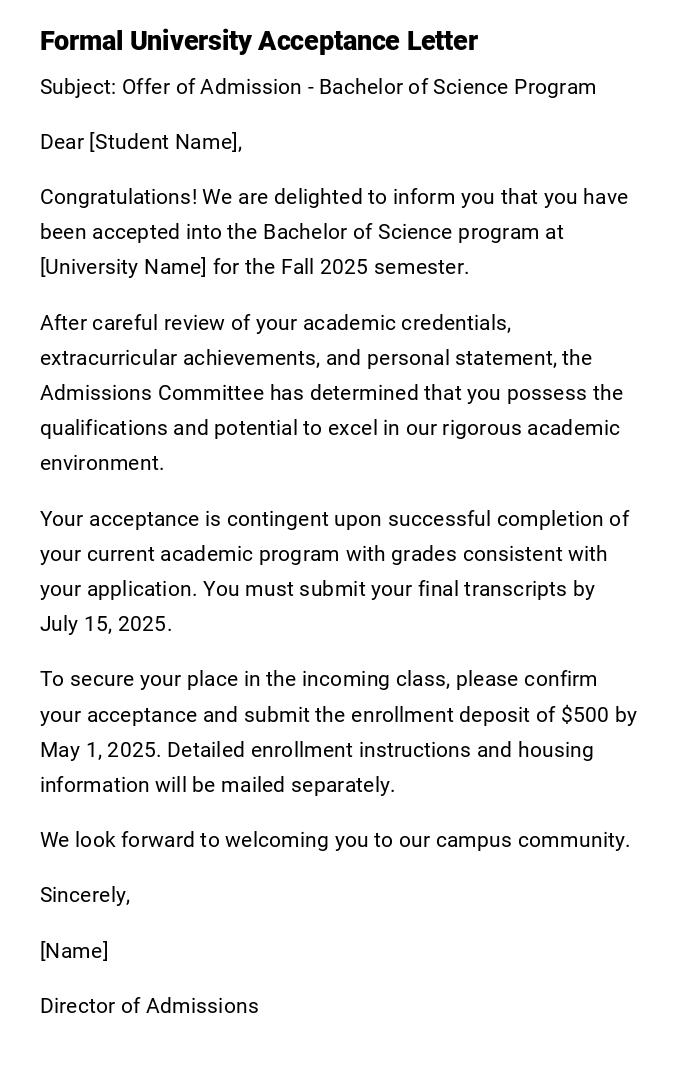
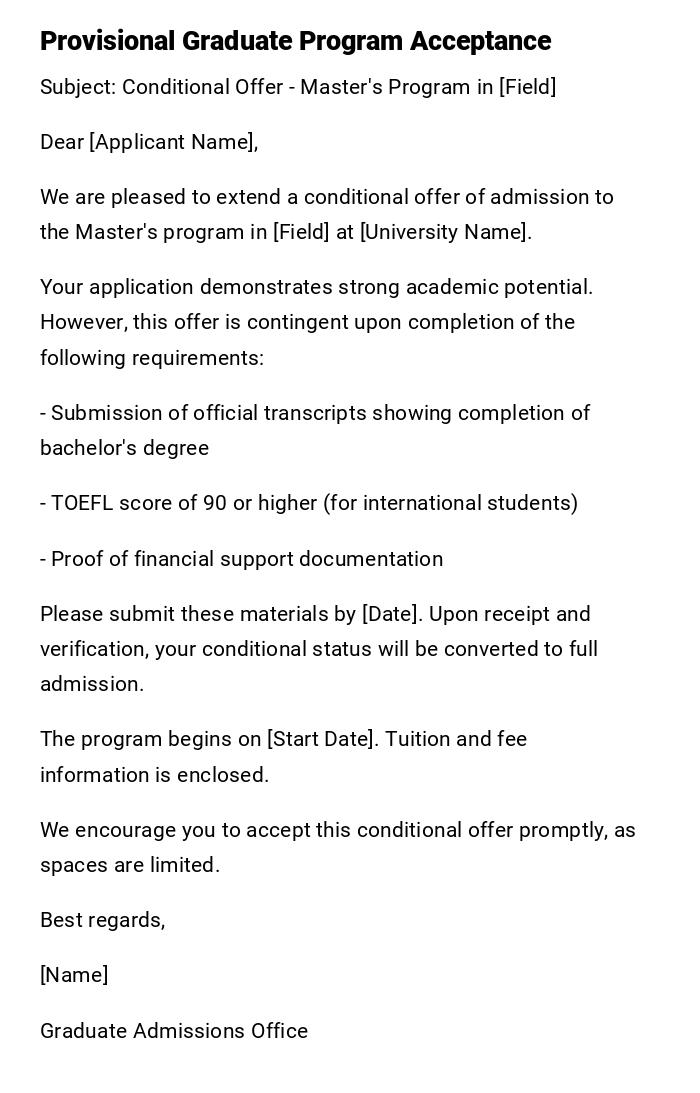
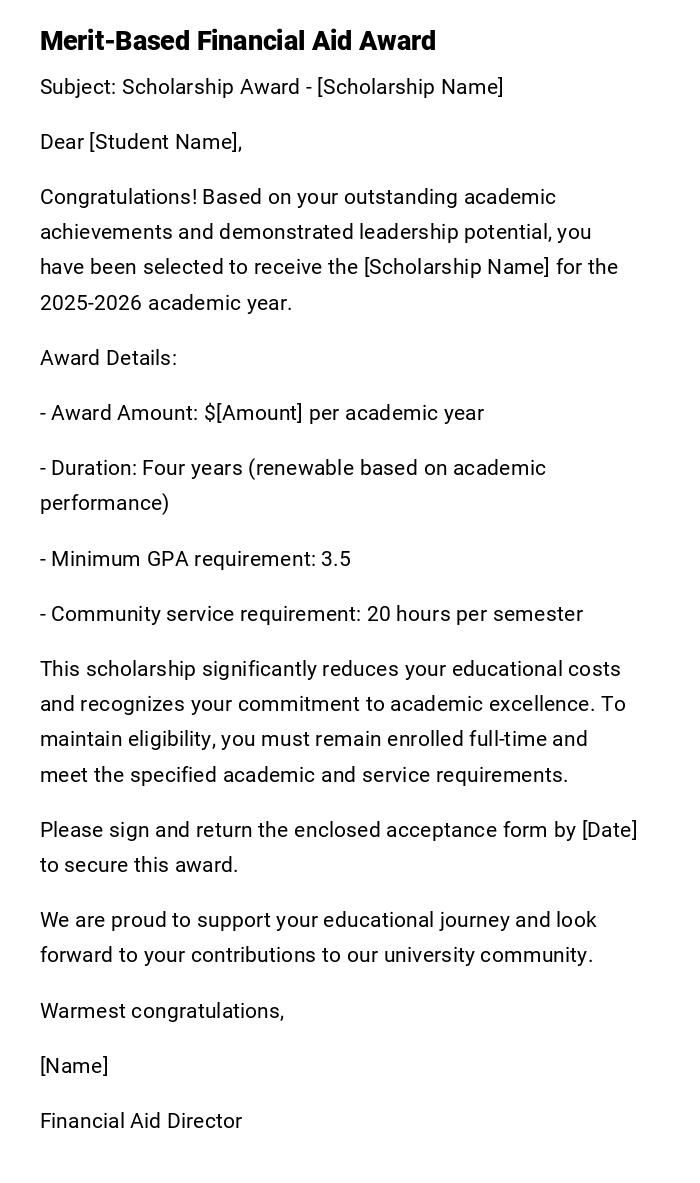
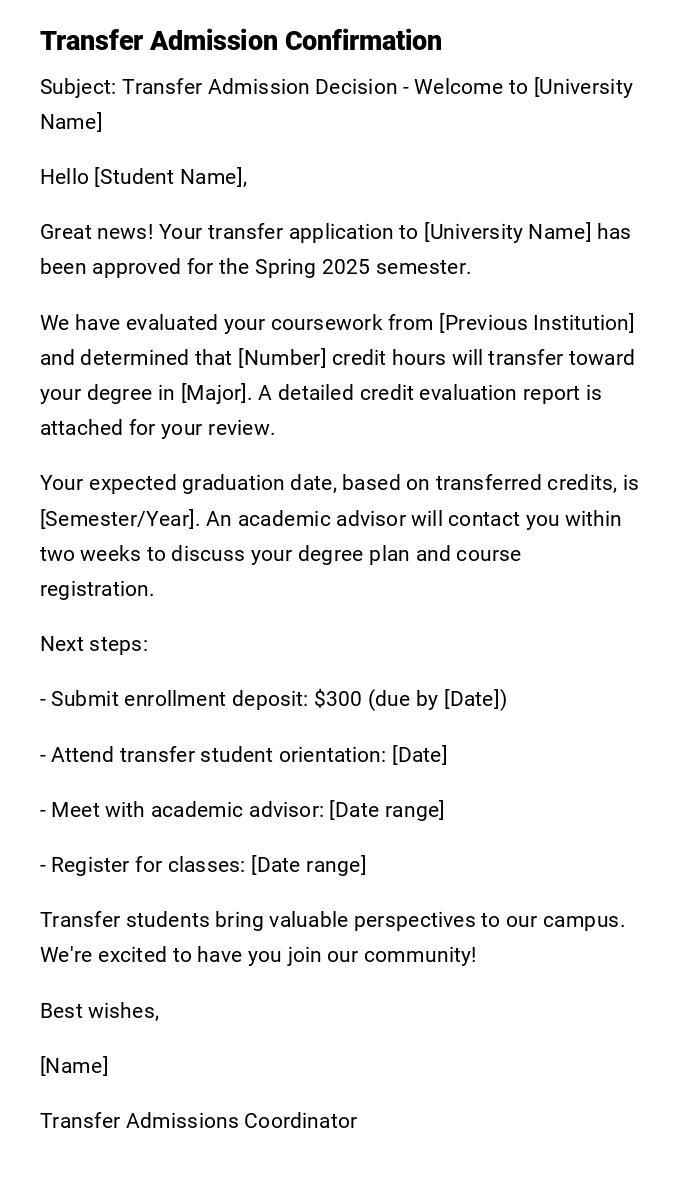
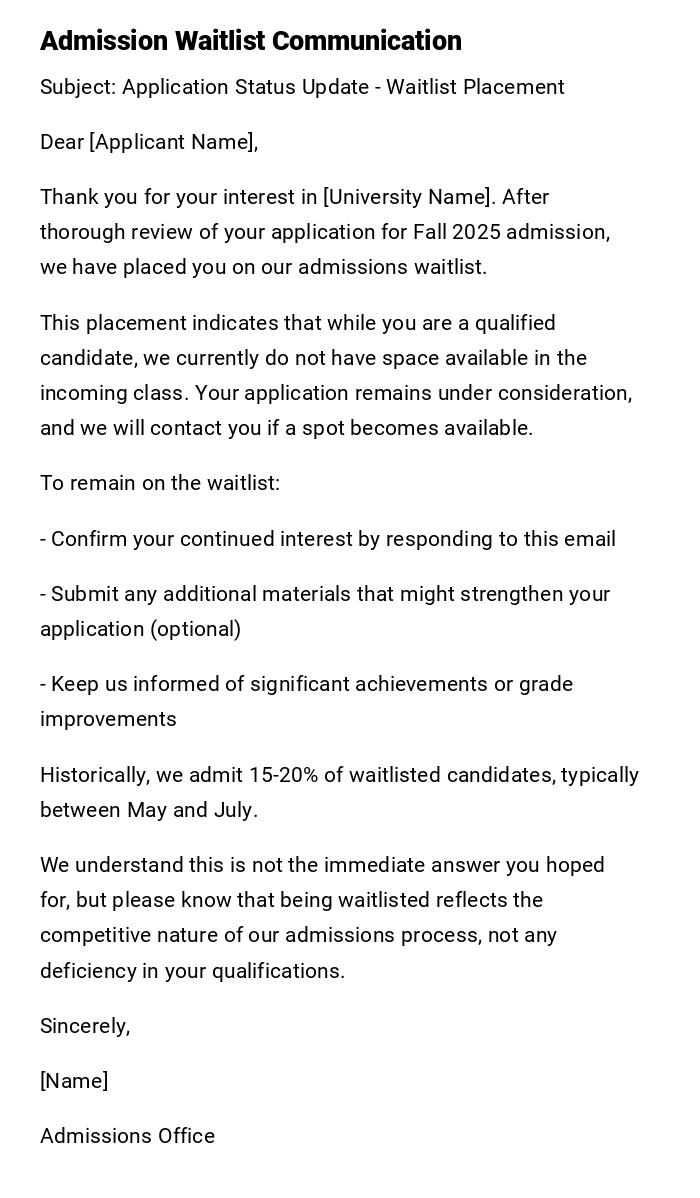
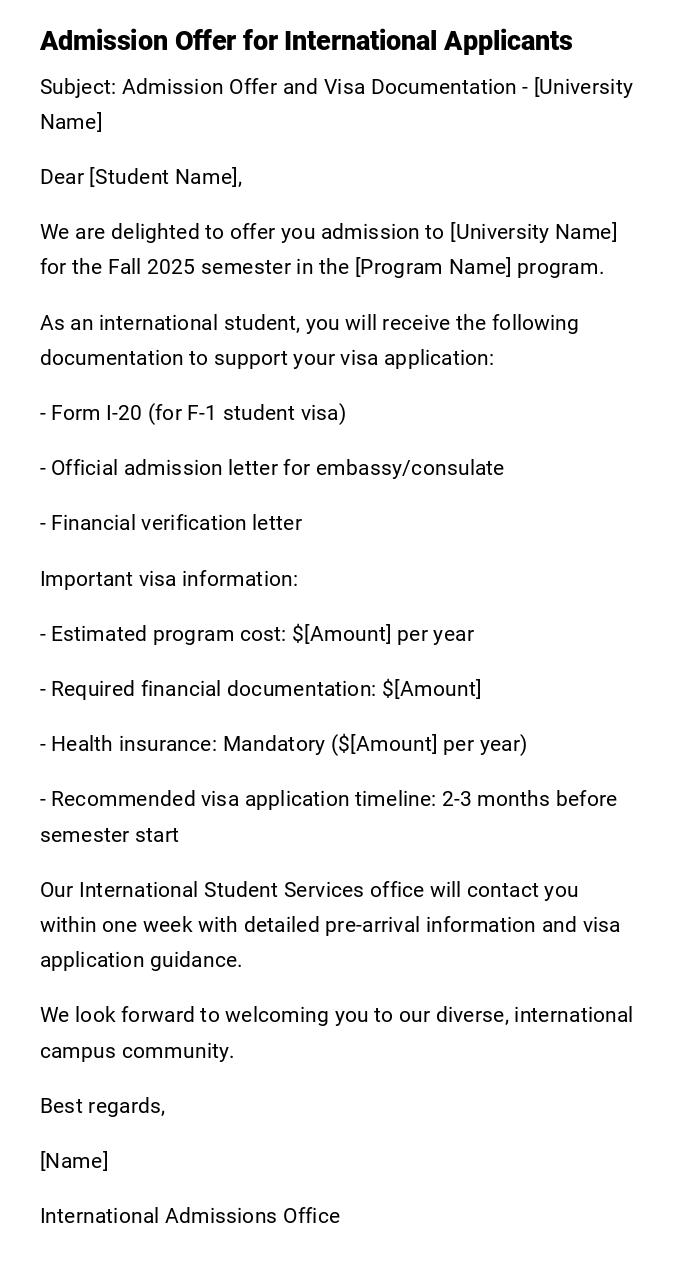
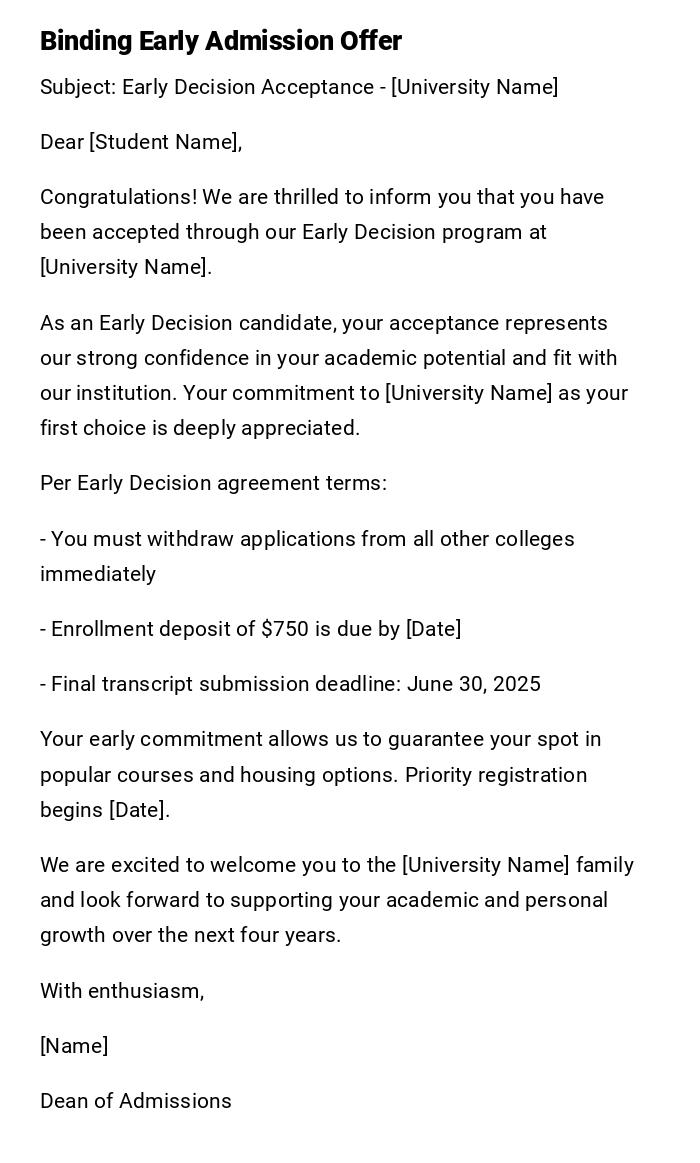
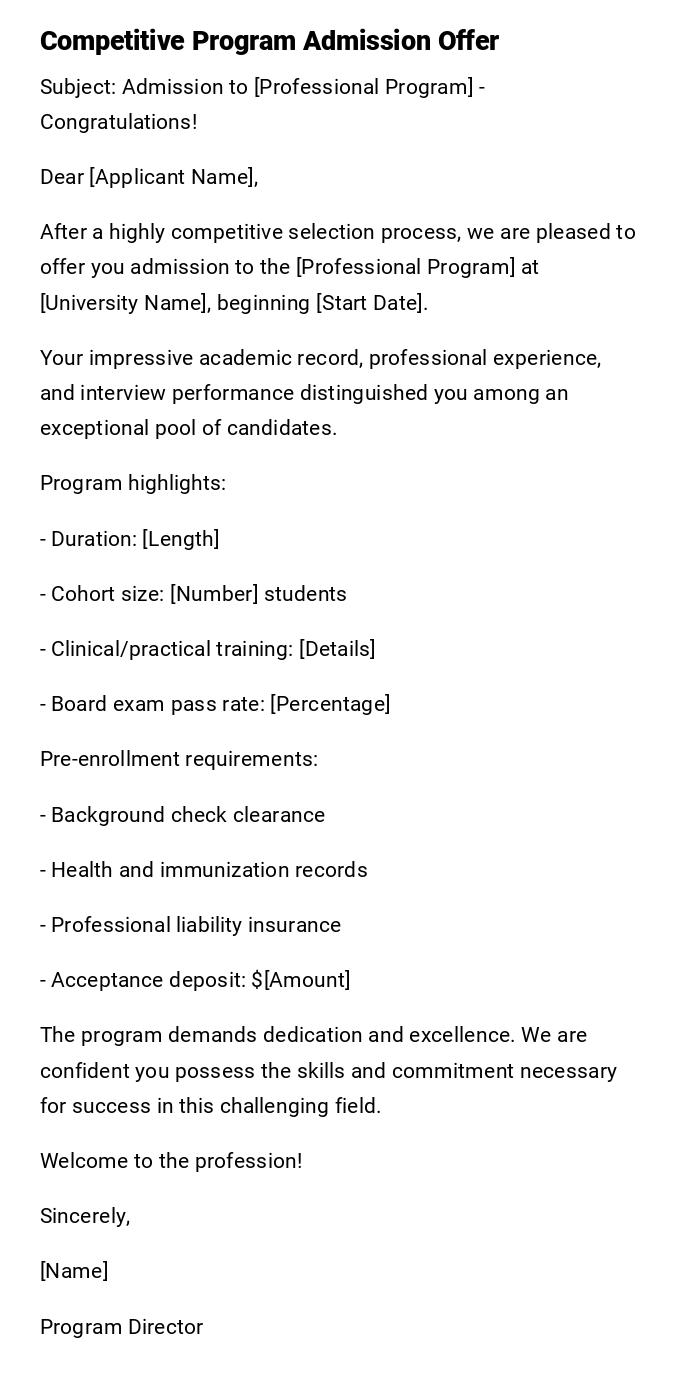

 Download Word Doc
Download Word Doc
 Download PDF
Download PDF